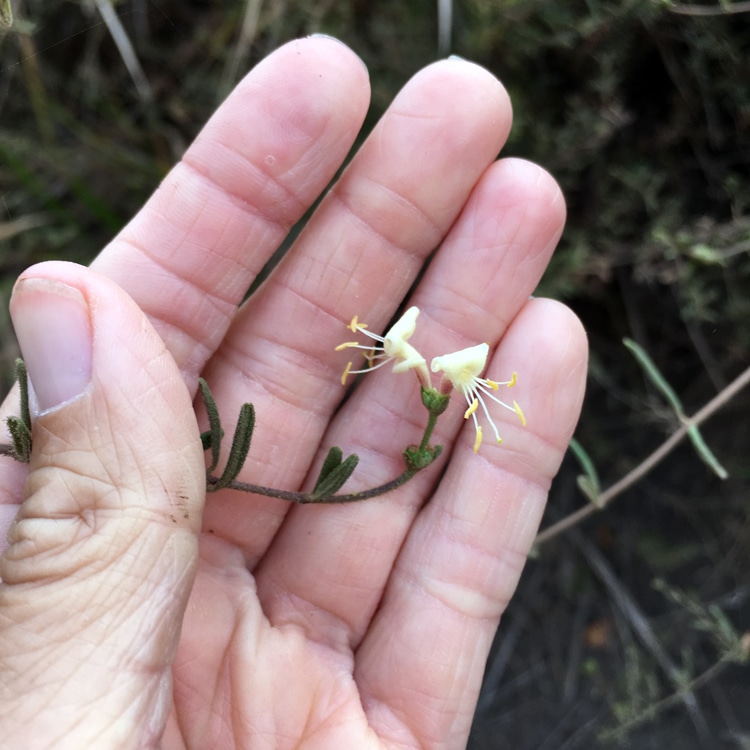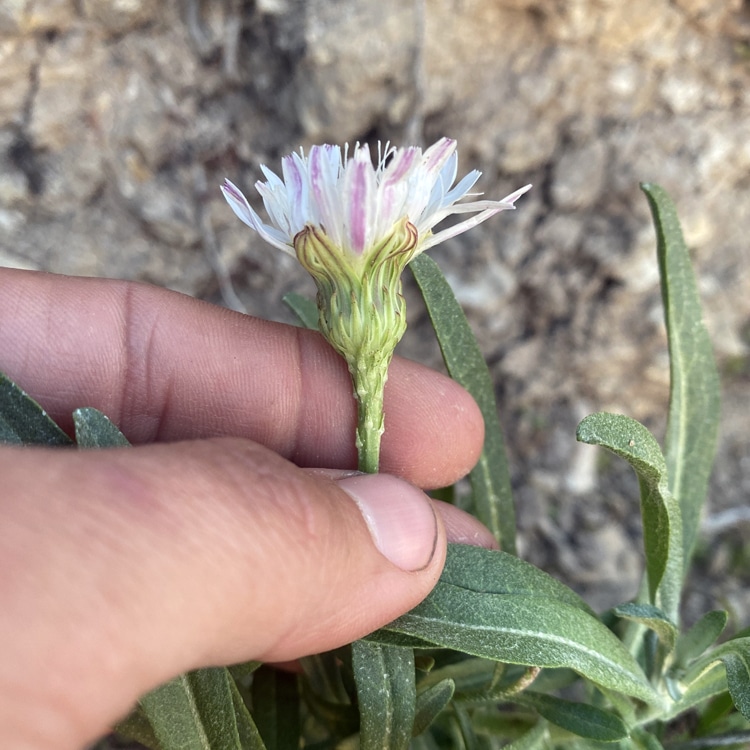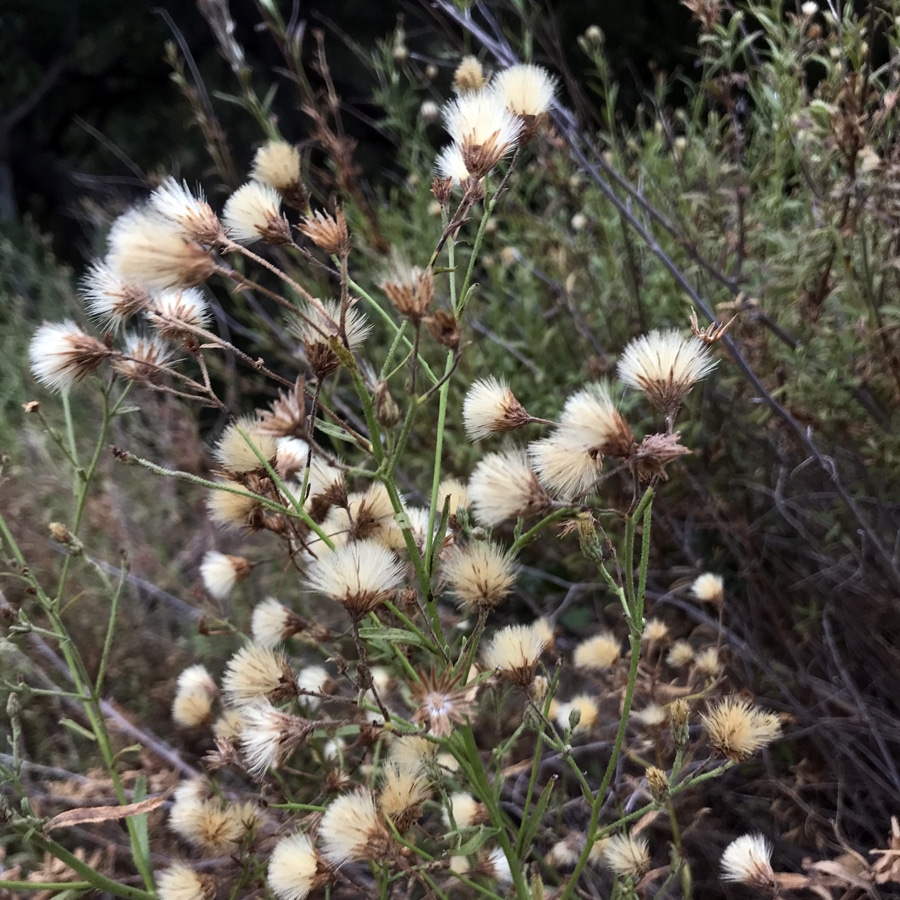Three rare California plant species were among more than 80 native plants counted during the assessment. Nearly 100 invasive, non-native plant species were found.
Park Ecology
Survey Plant List
Plant List from Assessment
California Native Species
| COMMON NAME | SCIENTIFIC NAME |
| Alkali mallow * | Malvella leprosa |
| American bird’s foot trefoil * | Acmispon americanus var. americanus |
| Arroyo lupine * | Lupinus succulentus |
| Arroyo willow * | Salix lasiolepis |
| Baby blue eyes * | Nemophila menziesii var. menziesii |
| Bermuda buttercup | Oxalis pes-caprae |
| Bird’s eye gilia * | Gilia tricolor |
| Black sage * | Salvia mellifera |
| Blue elderberry * | Sambucus nigra subsp. caerulea |
| Blue toadflax * | Nuttallanthus texanus |
| Bluehead gilia * | Gilia capitata |
| Branching phacelia * | Phacelia ramosissima |
| California bee plant * | Scrophularia californica |
| California blackberry * | Rubus ursinus |
| California brittlebush * | Encelia californica |
| California chicory * | Rafinesquia californica |
| California coffeeberry * | Frangula californica subsp. californica |
| California flannelbush * | Fremontodendron californicum |
| California hedge nettle * | Stachys bullata |
| California live oak * | Quercus agrifolia var. agrifolia |
| California melic * | Melica imperfecta |
| California mugwort * | Artemisia douglasiana |
| California sagebrush * | Artemisia californica |
| California wild rose * | Rosa californica |
| Chick lupine * | Lupinus microcarpus var. densiflourus |
| Christmas berry * | Heteromeles arbutifolia |
| Cleavers * | Galium aparine |
| Cliff aster # | Malacothrix saxatilis var. saxatilis |
| Cliff desert dandelion * | Malacothrix saxatilis var. tenuifolia |
| Climbing bedstraw * | Galium porrigens var. porrigens |
| Clustered dock * | Rumex conglomeratus |
| Coastal goldenbush * | Isocoma menziesii var. vernonioides |
| Common eucrypta * | Eucrypta chrysanthemifolia var. chrysanthemifolia |
| Common sandaster * | Corethrogyne filaginifolia |
| Contorted primrose * | Camissonia strigulosa |
| Cottonbatting plant * | Pseudognaphalium stramineum |
| Coyote brush * | Baccharis pilularis subsp. consanguinea |
| Creeping snowberry * | Symphoricarpos mollis |
| Deerweed * | Acmispon glaber var. glaber |
| Douglas’ nightshade * | Solanum douglasii |
| Elegant clarkia * | Clarkia unguiculata |
| Featherweed * | Gamochaeta ustulata |
| Foothill needle grass * | Stipa lepida |
| Fuchsia flowered gooseberry* | Ribes speciosum |
| Gamble weed * | Sanicula crassicaulis |
| Giant wild rye * | Elymus condensatus |
| Golden yarrow * | Eriophyllum confertiflorum var. confertiflorum |
| Hairy matilija poppy * | Romneya trichocalyx |
| Hairy wood sorrel * | Oxalis pilosa |
| Hoary nettle * | Urtica dioica subsp. holosericea |
| Hollyleaf redberry * | Rhamnus ilicifolia |
| Holly-leafed cherry * | Prunus ilicifolia subsp. ilicifolia |
| Hummingbird sage * | Salvia spathacea |
| Intermediate sun cups * | Camissoniopsis intermedia |
| Island false bindweed * | Calystegia macrostegia |
| Ladies’ tobacco * | Pseudognaphalium californicum |
| Laurel sumac * | Malosma laurina |
| Lemonade berry * | Rhus integrifolia |
| Lowland cudweed * | Gnaphalium palustre |
| Mock parsley * | Apiastrum angustifolium |
| Narrowleaf cattail * | Typha domingensis |
| Peppergrass * | Lepidium strictum |
| Pineapple weed * | Matricaria discoidea |
| Plummer’s baccharis # | Baccharis plummerae subsp. plummerae |
| Poison oak * | Toxicodendron diversilobum |
| Purple Chinese houses * | Collinsia heterophylla |
| Purple sage * | Salvia leucophylla |
| Saltmarsh bulrush * | Bolboschoenus maritimus subsp. paludosus |
| Santa Barbara honeysuckle # | Lonicera subspicata var. subspicata |
| Santa Cruz Island bush mallow * | Malacothamnus fasciculatus var. nuttallii |
| Saw toothed goldenbush * | Hazardia squarrosa |
| Small fescue * | Festuca microstachys |
| Southern bulrush * | Schoenoplectus californicus |
| Spiny redberry * | Rhamnus crocea |
| Sticky monkeyflower* | Diplacus longiflorus |
| Sticky phacelia * | Phacelia viscida var. albiflora |
| Tall cyperus * | Cyperus eragrostis |
| Telegraph weed * | Heterotheca grandiflora |
| Toad rush * | Juncus bufonius |
| Two-color rabbit-tobacco * | Pseudognaphalium biolettii |
| Vervain * | Verbena lasiostachys var. lasiostachys |
| Western blue eyed grass * | Sisyrinchium bellum |
| Western sycamore * | Platanus racemosa |
| Wild honeysuckle * | Oenothera suffrutescens |
| Wishbone bush * | Mirabilis laevis var. crassifolia |
| Wright’s cudweed * | Pseudognaphalium microcephalum |
Invasive Species
| COMMON NAME | SCIENTIFIC NAME |
| African asparagus fern | Asparagus asparagoides |
| African cornflag | Chasmanthe floribunda |
| Annual beard grass | Polypogon monspeliensis |
| Annual blue grass | Poa annua |
| Annual yellow sweetclover | Melilotus indicus |
| Asphodel | Asphodelus fistulosus |
| Australian cheesewood | Pittosporum undulatum |
| Australian saltbush | Atriplex semibaccata |
| Black mustard | Brassica nigra |
| Bladderflower | Araujia sericifera |
| Blessed milkthistle | Silybum marianum |
| Brazilian pepper tree | Schinus terebinthifolius |
| Bristly ox-tongue | Helminthotheca echioides |
| Bristly tail seed | Urospermum picroides |
| Broad leaf filaree | Erodium botrys |
| Bulbous canarygrass | Phalaris aquatica |
| Bur clover | Medicago polymorpha |
| Canary Island palm | Phoenix canariensis |
| Cape ivy | Delairea odorata |
| Castor bean | Ricinus communis |
| Chaparral clematis | Clematis lasiantha |
| Charlock mustard | Sinapis arvensis |
| Cheeseweed mallow | Malva parviflora |
| Chickweed | Stellaria media |
| Chinese lantern tree | Koelreutaria sp. |
| Coastal lotus | Acmispon maritimus |
| Common sow thistle | Sonchus oleraceus |
| Cranesbill | Geranium dissectum |
| Cretan mallow | Malva pseudolavatera |
| Crimson fountaingrass | Pennisetum setaceum |
| Curly dock | Rumex crispus |
| English ivy | Hedera helix |
| English plantain | Plantago lanceolata |
| Eucalyptus | Eucalyptus sp. |
| False brome | Brachypodium distachyon |
| Fennel | Foeniculum vulgare |
| Field bindweed | Convolvulus arvensis |
| Finestem needlegrass | Nassella tenuissima |
| Four leaved allseed | Polycarpon tetraphyllum var. tetraphyllum |
| Foxtail chess | Bromus madritensis |
| Garden nasturtium | Tropaeolum majus |
| Geraldton carnation weed | Euphorbia terracina |
| Greenstem filaree | Erodium moschatum |
| Hairy vetch | Vicia villosa |
| Hyssop loosestrife | Lythrum hyssopifolia |
| Italian rye grass | Festuca perennis |
| Italian thistle | Carduus pycnocephalus |
| Maltese star thistle | Centaurea melitensis |
| Mediterranean hoary mustard | Hirschfeldia incana |
| Mediterranean pygmy weed | Crassula tillaea |
| Mexican fan palm | Washingtonia robusta |
| Narrowleaf cottonrose | Logfia gallica |
| Nightshade | Solanum sp. |
| Nit grass | Gastridium phleoides |
| Olive | Olea europaea |
| Panic veldtgrass | Ehrharta erecta |
| Peruvian pepper tree | Schinus molle |
| Petty spurge | Euphorbia peplus |
| Pigmy weed | Crassula connata |
| Poison hemlock | Conium maculatum |
| Prickly lettuce | Lactuca serriola |
| Prickly sow thistle | Sonchus asper subsp. asper |
| Pride of Madeira | Echium candicans |
| Prostrate knotweed | Polygonum aviculare |
| Purple pampas grass | Cortaderia jubata |
| Purple vetch | Vicia benghalensis |
| Radish | Raphanus sativus |
| Ragweed | Ambrosia psilostachya |
| Rattail sixweeks grass | Festuca myuros |
| Red brome | Bromus madritensis subsp. rubens |
| Redstem filaree | Erodium cicutarium |
| Rescue grass | Bromus catharticus var. catharticus |
| Ripgut grass | Bromus diandrus |
| Saltmarsh sand spurry | Spergularia marina |
| Scarlet pimpernel | Lysimachia arvensis |
| Sea fig | Carpobrotus chilensis |
| Slender wild oat | Avena barbata |
| Small-flower catchfly | Silene gallica |
| Smilo grass | Stipa miliacea var. miliacea |
| Soft brome | Bromus hordeaceus |
| Spineless yucca | Yucca gigantea |
| Spring vetch | Vicia sativa |
| Sticky snakeroot | Ageratina adenophora |
| Sweet alyssum | Lobularia maritima |
| Tree tobacco | Nicotiana glauca |
| Uruguayan pampas grass | Cortaderia selloana |
| Wall barley | Hordeum murinum |
| Wattle | Acacia sp. |
| White horehound | Marrubium vulgare |
| White sweetclover | Melilotus albus |
| Wild oat | Avena fatua |
What Does “Special Status” Mean?
“Special status species” is used in the scientific community and this report for plant communities, and plant and animal species that are considered sufficiently rare that they require special consideration and/or protection, and should be or have been listed as rare, threatened, or endangered by the Federal and/or State governments.
Three Rare Native Plant Species Found
The survey’s literature review revealed 54 special-status California native plant species that could potentially grow in Elings Park. Three of these species were observed and mapped:
- 2 Plummer’s baccharis (Baccharis plummerae ssp. Plummerae)
- 10 Santa Barbara honeysuckle (Lonicera subspicta ssp. subspicata)
- 40 cliff malacothrix (Malacothrix saxatilis var. saxatilis)
The report also evaluated if the Park could support additional special-status plants, looking at suitable habitats, proximity to existing populations, amount of time since last observation, and elevation.
This is useful for the park’s planning for future restoration efforts, which could potentially include planting special-status plants.

There are five varieties of cliff aster, but Elings Park was found to contain the rare Malacothrix saxatilis var. saxatilis. A native perennial herb, it usually grows along cliffs in coastal scrub in Central and Southern California. The flowers are white to yellow and bloom from spring through summer.
Lonicera subspicata var. Subspicata credit SB Botanic Garden

Unlike Santa Barbara honeysuckle’s common “denudate” variety, Lonicera subspicata var. Subspicata is rare and found only in limited locations including Santa Barbara County, and Catalina and Santa Cruz islands. It climbs on other plants for support, features yellow-white flowers, and produces red berries.
Malacothrix saxatilis var. saxatilis credit iNaturalist

Plummer’s baccharis (Baccharis plummerae ssp. Plummerae) is found only in California and was named in honor of American botanist Sara Plummer Lemmon (1836-1923) who discovered it. The shrub is dioecious, meaning male and female plants produce flower heads of different types. It grows in coastal sage scrub and can reach more than six feet tall.
Baccharis plummerae ssp. Plummerae credit iNaturalist
A global and state ranking system determines the rarity of a plant species or community. “Special status species” are those considered sufficiently rare that they require special consideration and/or protection, and should be or have been listed as rare, threatened, or endangered by the Federal and/or State governments.
Invasive Plants Recommended for Mitigation
Of the nearly 100 invasive species observed in the Park, 32 species were identified, mapped, and prioritized for possible removal. These areas contain species either newly or not yet established species that were easily controlled.
Some Park areas were not mapped though they contained invasive plant species. This happened in instances when the invasive plants were not easily controlled, were well established, or would require significant effort to be treated.
African cornflag (Chasmanthe floribunda)
Asphodel (Asphodelus fistulosus)
Australian cheesewood (Pittosporum undulatum)
Bladderflower (Araujia sericifera)
Blessed milkthistle (Silybum marianum)
Brazilian pepper tree (Schinus terebinthifolius)
Bulbous canarygrass (Phalaris aquatica)
Canary Island palm (Phoenix canariensis)
Cape ivy (Delairea odorata)
Castor bean (Ricinus communis)
Chinese lantern tree (Koelreutaria sp.)
Crimson fountaingrass (Pennisetum setaceum)
English ivy (Hedera helix)
Fennel (Foeniculum vulgare)
Finestem needlegrass (Nassella tenuissima)
Garden nasturtium (Tropaeolum majus)
Geraldton carnation weed (Euphorbia terracina)
Hairy vetch (Vicia villosa)
Italian thistle (Carduus pycnocephalus)
Mexican fan palm (Washingtonia robusta)
Nightshade (Solanum sp.)
Olive (Olea europaea)
Peruvian pepper tree (Schinus molle)
Poison hemlock (Conium maculatum)
Pride of Madeira (Echium candicans)
Purple pampas grass (Cortaderia jubata)
Sea fig (Carpobrotus chilensis)
Spineless yucca (Yucca gigantea)
Sticky snakeroot (Ageratina adenophora)
Tree tobacco (Nicotiana glauca)
Uruguayan pampas grass (Cortaderia selloana)
Wattle (Acacia sp.)
Support the Park
Elings Park is not operated by the city or county. We depend on user fees and public donations to maintain and improve the park. You can help.

